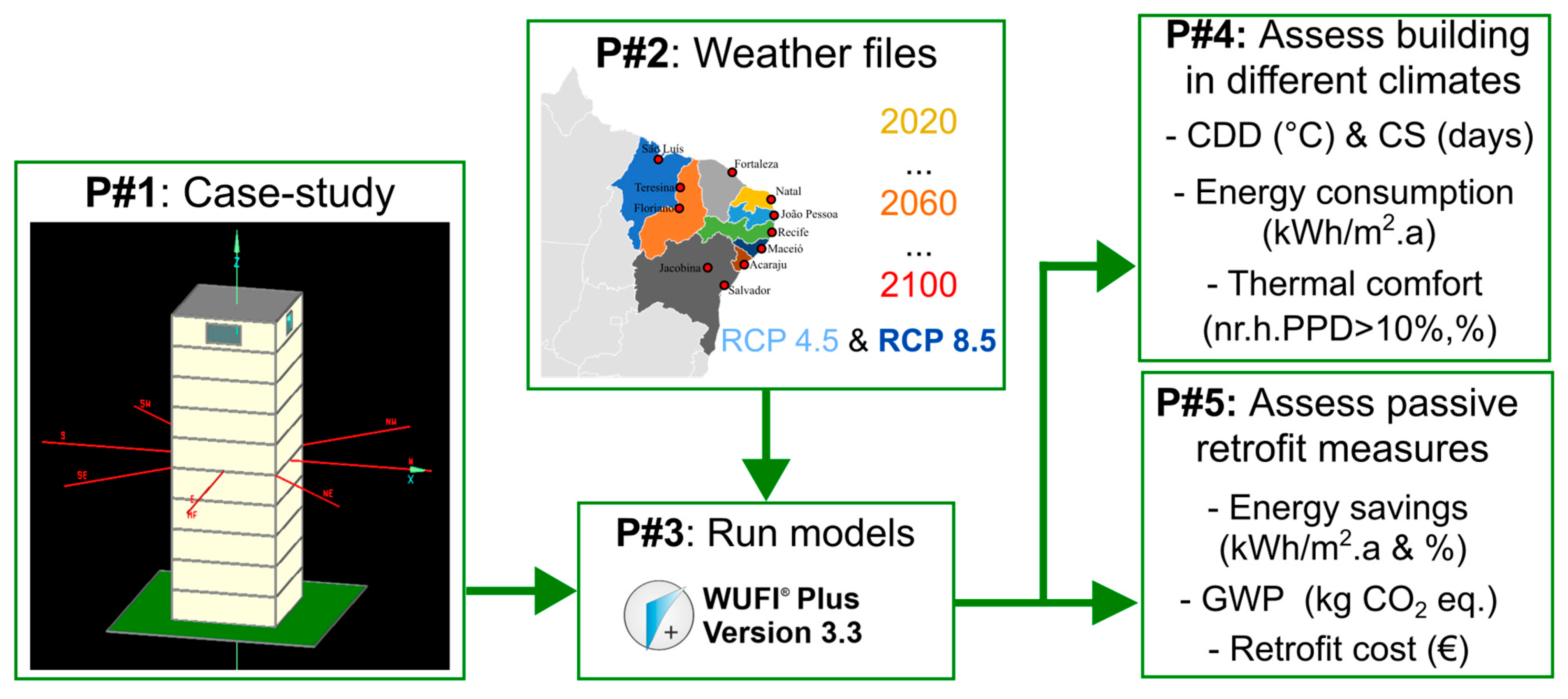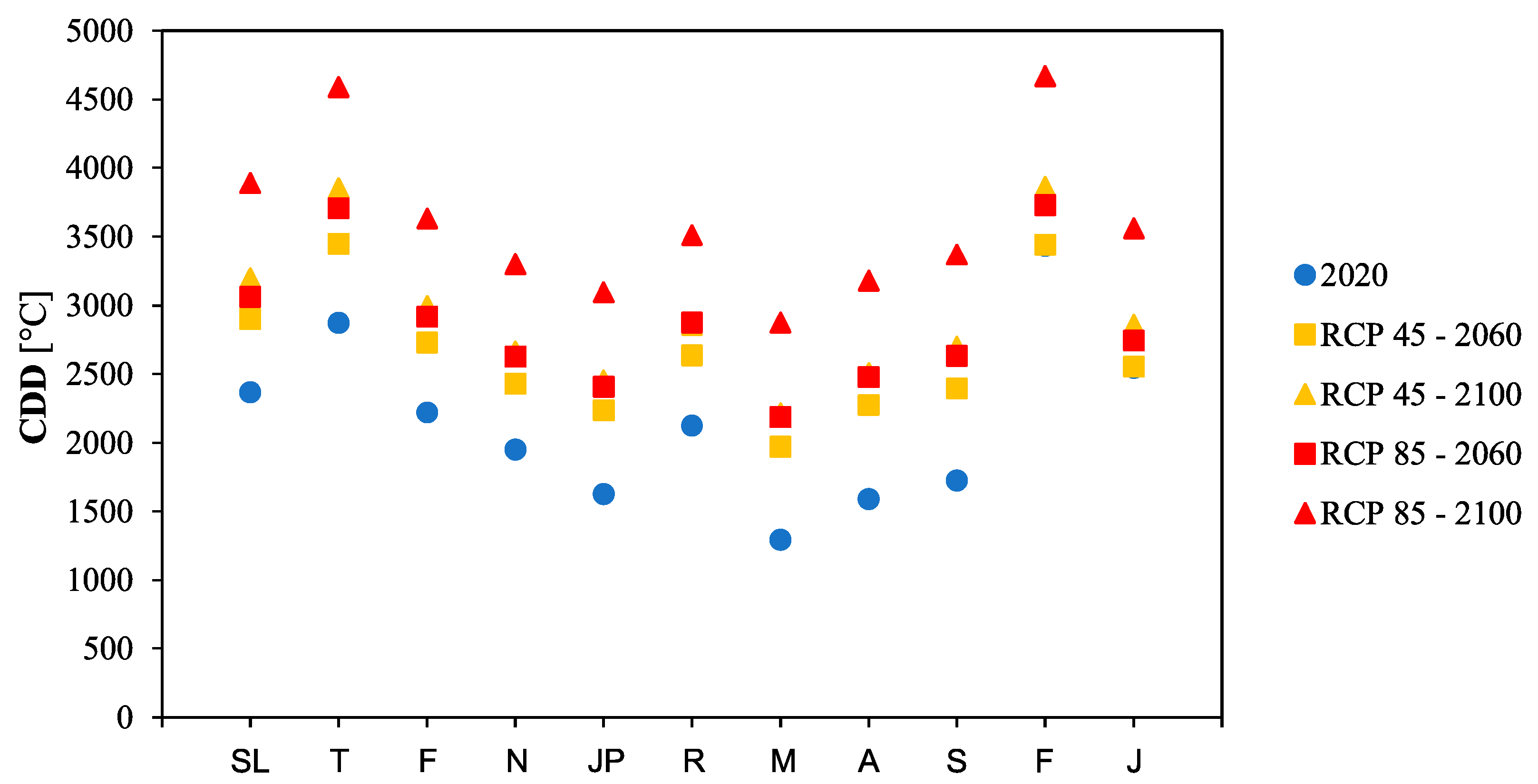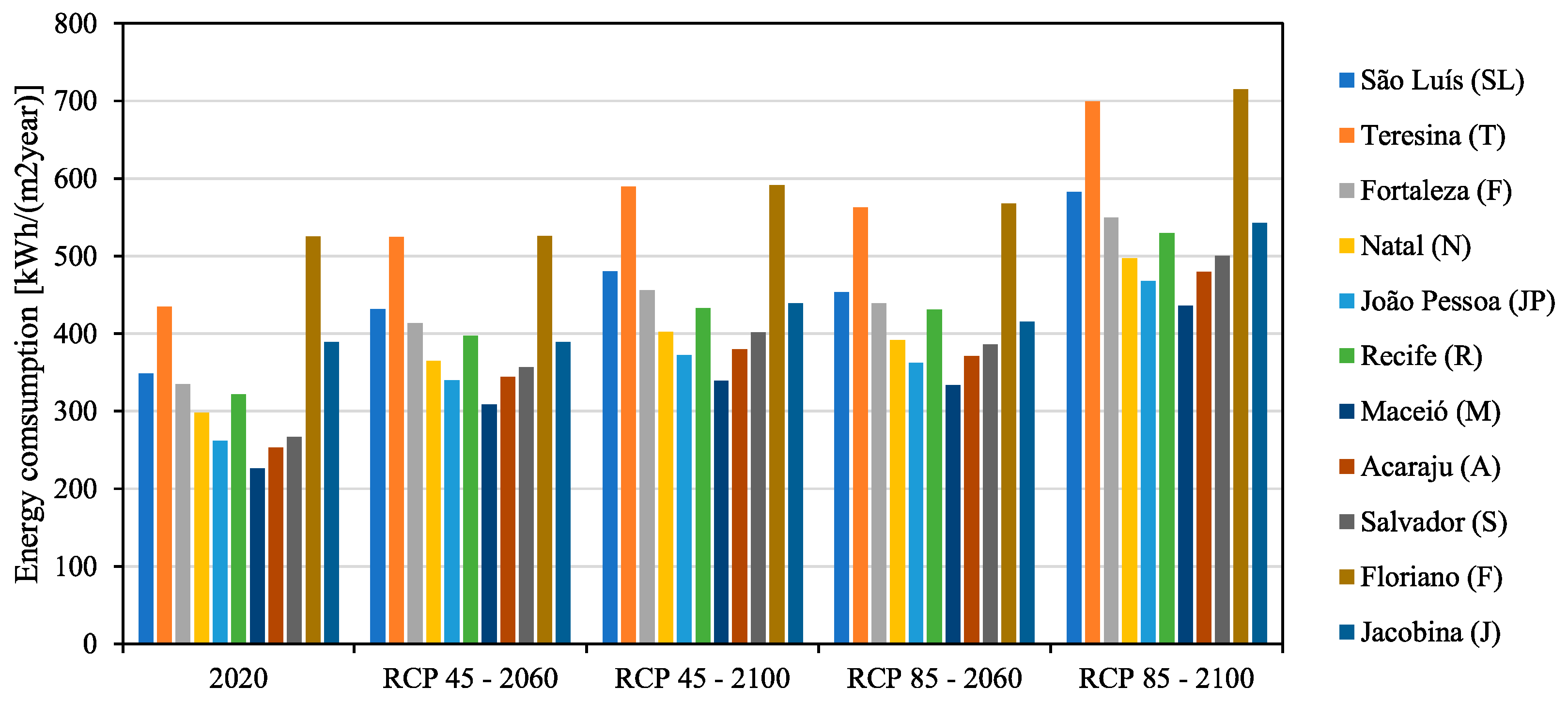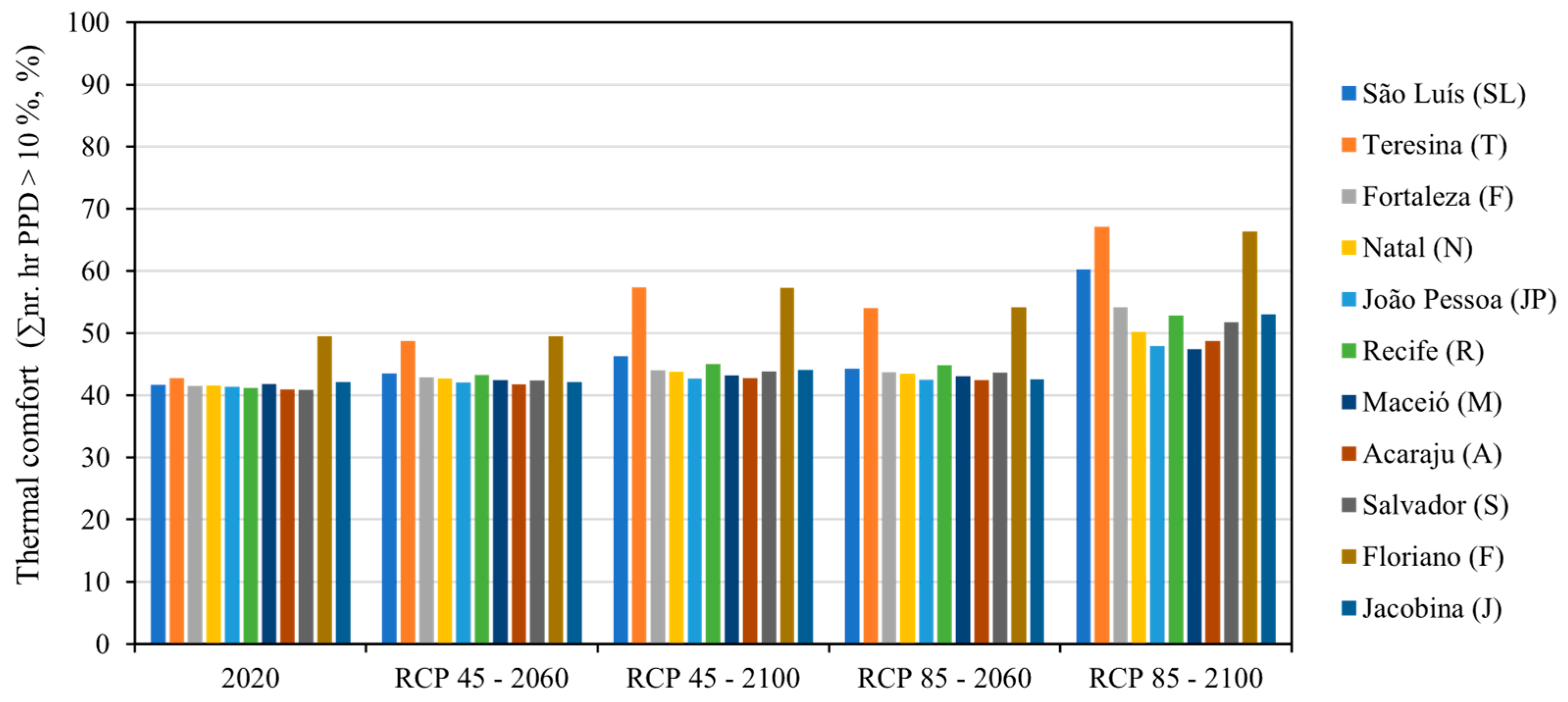Eco-Efficient Thermal Rehabilitation of Residential Buildings in Northeast Brazil Through Thermal Modeling Considering Future Climate Needs †
Abstract
:1. Introduction
1.1. Background
1.2. Overview of Previous Studies
1.3. Scope and Objectives
2. Methodology
2.1. General Considerations
2.2. Case Study and the Computational Model
2.3. Selected Climates
2.4. Energy Consumption Indices
if Tm > 15 °C then HDD = 0
if Tm < 24 °C then CDD = 0
2.5. Thermal Comfort Indices
2.6. Cost Calculations
3. Results and Discussion
3.1. Future CDD and CS
3.2. Energy Consumption
3.3. Thermal Comfort
3.4. Improvement Measures
- Roofing—Application of thermal insulation in panels of: (a) extruded expanded polystyrene (XPS), synthetic, to be applied over the existing sealing system, under heavy protection, and (b) lightweight hemp-based boards, to be applied under the waterproofing system, with the inclusion of an additional thermal insulation, which is considered to be a good example of bio-based thermal (and acoustic) insulation.
- Glazing—Replacement of single glazing with: (a) double glazing with thermal resistance of 2.6 W/(m2·K) and solar factor of 0.78, and (b) double glazing with equal thermal resistance of 2.6 W/(m2·K) and low solar factor of 0.09.
- External walls—Application, on the inside, of thermal insulation in plates consisting of (a) molded EPS, synthetic, to be covered with plasterboard plates, and (b) lightweight hemp-based boards, and acoustic insulation, which can be coated with plaster, although it could be left uncoated.
4. Conclusions
Author Contributions
Funding
Data Availability Statement
Acknowledgments
Conflicts of Interest
References
- Intergovernmental Panel on Climate Change (IPCC). Climate Change 2014: Synthesis Report. Contribution of Working Groups I, II and III to the Fifth Assessment Report of the Intergovernmental Panel on Climate Change; Pachauri, R.K., Meyer, L.A., Eds.; Cambridge University Press: New York, NY, USA, 2014. [Google Scholar] [CrossRef]
- Roca-Musach, M.; Alonso-Montolio, C.; Cabillo, I.C.; Coch, H. The resilience of buildings to climate change: The role of mobile passive systems. J. Phys. Conf. Ser. 2023, 2600, 092029. [Google Scholar] [CrossRef]
- Attia, S.; Benzidane, C.; Rahif, R.; Amaripadath, D.; Hamdy, M.; Holzer, P.; Koch, A.; Maas, A.; Moosberger, S.; Petersen, S.; et al. Overheating calculation methods, criteria, and indicators in European regulation for residential buildings. Energy Build. 2023, 292, 113170. [Google Scholar] [CrossRef]
- Salameh, M.; Touqan, B. Traditional Passive Design Solutions as a Key Factor for Sustainable Modern Urban Designs in the Hot, Arid Climate of the United Arab Emirates. Buildings 2022, 12, 1811. [Google Scholar] [CrossRef]
- Silva, R.; Eggimann, S.; Fierz, L.; Fiorentini, M.; Orehounig, K.; Baldini, L. Opportunities for passive cooling to mitigate the impact of climate change in Switzerland. Build. Environ. 2022, 208, 108574. [Google Scholar] [CrossRef]
- Mohammadi, A.; Daraio, J.A. Improving the Energy Efficiency of Existing Residential Buildings by Applying Passive and Cost-Effective Solutions in the Hot and Humid Region of Iran. Space Ontol. Int. J. 2020, 9, 77–96. [Google Scholar] [CrossRef]
- Klepeis, N.E.; Nelson, W.C.; Ott, W.; Robinson, J.P. The National Human Activity Pattern Survey (NHAPS): A Resource for Assessing Exposure to Environmental Pollutants. J. Expo. Anal. Environ. Epidemiol. 2001, 11, 231–252. [Google Scholar] [CrossRef]
- United Nations Environment Programme. Building Materials and the Climate: Constructing a New Future; United Nations Environment Programme: Nairobi, Kenya, 2023. [Google Scholar]
- Liu, S.; Kwok, Y.T.; Lau, K.K.-L.; Ouyang, W.; Ng, E. Effectiveness of passive design strategies in responding to future climate change for residential buildings in hot and humid Hong Kong. Energy Build. 2020, 228, 110469. [Google Scholar] [CrossRef]
- Hu, M.; Zhang, K.; Nguyen, Q.; Tasdizen, T. The effects of passive design on indoor thermal comfort and energy savings for residential buildings in hot climates: A systematic review. Urban Clim. 2023, 49, 101466. [Google Scholar] [CrossRef]
- Dabaieh, M.; Wanas, O.; Hegazy, M.A.; Johansson, E. Reducing cooling demands in a hot dry climate: A simulation study for non-insulated passive cool roof thermal performance in residential buildings. Energy Build. 2015, 89, 142–152. [Google Scholar] [CrossRef]
- Kovacic, I.; Reisinger, J.; Honic, M. Life Cycle Assessment of embodied and operational energy for a passive housing block in Austria. Renew. Sustain. Energy Rev. 2018, 82, 1774–1786. [Google Scholar] [CrossRef]
- Almusaed, A.; Almssad, A.; Alasadi, A.; Yitmen, I.; Al-Samaraee, S. Assessing the Role and Efficiency of Thermal Insulation by the “BIO-GREEN PANEL” in Enhancing Sustainability in a Built Environment. Sustainability 2023, 15, 10418. [Google Scholar] [CrossRef]
- Cintura, E.; Faria, P.; Molari, L.; Barbaresi, L.; D’Orazio, D.; Nunes, L. A feasible re-use of an agro-industrial by-product: Hazelnut shells as high-mass bio-aggregate in boards for indoor applications. J. Clean. Prod. 2024, 434, 140297. [Google Scholar] [CrossRef]
- Alves, C.A.; Duarte, D.H.; Gonçalves, F.L. Residential buildings’ thermal performance and comfort for the elderly under climate changes context in the city of São Paulo, Brazil. Energy Build. 2016, 114, 62–71. [Google Scholar] [CrossRef]
- Falegari, S.; Javid, A.A.S. Integrating building information modeling and life cycle assessment to analyze the role of climate and passive design parameters in energy consumption. Energy Environ. 2024, 35, 2078–2106. [Google Scholar] [CrossRef]
- Harkouss, F.; Fardoun, F.; Biwole, P.H. Passive design optimization of low energy buildings in different climates. Energy 2018, 165, 591–613. [Google Scholar] [CrossRef]
- DesignBuilder Software Ltd. DesignBuilder. Available online: https://designbuilder.co.uk/ (accessed on 12 February 2025).
- Dalbem, R.; da Cunha, E.G.; Vicente, R.; Figueiredo, A.; Oliveira, R.; da Silva, A.C.S.B. Optimisation of a social housing for south of Brazil: From basic performance standard to passive house concept. Energy 2019, 167, 1278–1296. [Google Scholar] [CrossRef]
- EnergyPlus™. EnergyPlus. Available online: https://energyplus.net/ (accessed on 12 February 2025).
- Vázquez-Torres, C.E.; Bienvenido-Huertas, D.; Beizaee, A.; Bassam, A.; Torres, M.J. Thermal performance of historic buildings in Mexico: An analysis of passive systems under the influence of climate change. Energy Sustain. Dev. 2023, 72, 100–113. [Google Scholar] [CrossRef]
- EDSL USA, Inc. TAS: Thermal Analysis Software: Purpose-Built, Interoperable Programs that Facilitate Methodical Workflows. Available online: https://www.edsltas.com/about-tas/ (accessed on 12 February 2025).
- Stephan, A.; Crawford, R.H.; de Myttenaere, K. A comprehensive assessment of the life cycle energy demand of passive houses. Appl. Energy 2013, 112, 23–34. [Google Scholar] [CrossRef]
- Cintura, E.; Nunes, L.; Esteves, B.; Faria, P. Agro-industrial wastes as building insulation materials: A review and challenges for Euro-Mediterranean countries. Ind. Crops Prod. 2021, 171, 113833. [Google Scholar] [CrossRef]
- Collet, F.; Mertens, S.; Faria, P. RILEM TC 275-HDB round-robin tests and proposals: Moisture buffer value of vegetal concrete. Mater. Struct. 2025, 58, 36. [Google Scholar] [CrossRef]
- Cintura, E.; Faria, P.; Duarte, M.; Nunes, L. Bio-Wastes as Aggregates for Eco-Efficient Boards and Panels: Screening Tests of Physical Properties and Bio-Susceptibility. Infrastructures 2022, 7, 26. [Google Scholar] [CrossRef]
- Cintura, E.; Faria, P.; Duarte, M.; Nunes, L. Eco-efficient boards with agro-industrial wastes–Assessment of different adhesives. Constr. Build. Mater. 2023, 404, 132665. [Google Scholar] [CrossRef]
- Elmoudnia, H.; Millogo, Y.; Faria, P.; Jalal, R.; Waqif, M.; Saâdi, L. Development of Doum Palm Fiber-Based Building Insulation Composites with Citric Acid/Glycerol Eco-Friendly Binder. J. Compos. Sci. 2025, 9, 67. [Google Scholar] [CrossRef]
- Cintura, E.; Faria, P.; Molari, L.; Barbaresi, L.; D’Orazio, D.; Nunes, L. Characterization of an Arundo donax-based composite: A solution to improve indoor comfort. Ind. Crops Prod. 2024, 208, 117756. [Google Scholar] [CrossRef]
- Bourbia, S.; Kazeoui, H.; Belarbi, R. A review on recent research on bio-based building materials and their applications. Mater. Renew. Sustain. Energy 2023, 12, 117–139. [Google Scholar] [CrossRef]
- Boulebbina, C.; Mebarki, G.; Rahal, S. Passive solar house prototype design with a new bio-based material for a semi-arid climate. Mater. Renew. Sustain. Energy 2022, 11, 1–15. [Google Scholar] [CrossRef]
- Kubiś, M.; Łapka, P.; Cieślikiewicz, Ł.; Sahmenko, G.; Sinka, M.; Bajare, D. Analysis of the Thermal Conductivity of a Bio-Based Composite Made of Hemp Shives and a Magnesium Binder. Energies 2022, 15, 5490. [Google Scholar] [CrossRef]
- Gourlay, E.; Glé, P.; Marceau, S.; Foy, C.; Moscardelli, S. Effect of water content on the acoustical and thermal properties of hemp concretes. Constr. Build. Mater. 2017, 139, 513–523. [Google Scholar] [CrossRef]
- Autodesk Inc. Autodesk Revit: BIM Software to Design and Make Anything. Available online: https://www.autodesk.com/products/revit/overview?term=1-YEAR&tab=subscription (accessed on 12 February 2025).
- Autodesk Inc. Building Performance Analysis: Raised to the Power of the Cloud. Available online: https://gbs.autodesk.com/gbs (accessed on 12 February 2025).
- Autodesk Inc. Better Building Performance: Autodesk® Insight is a Powerful Guide to Better Building Energy and Environmental Performance. Available online: https://insight360.autodesk.com/oneenergy (accessed on 12 February 2025).
- One Click LCA Ltd. Available online: https://oneclicklca.com/ (accessed on 29 January 2025).
- Autodesk Inc. Dynamo Studio. Available online: https://www.autodesk.com/products/dynamo-studio/overview (accessed on 12 February 2025).
- Vettorazzi, E.; Figueiredo, A.; Rebelo, F.; Vicente, R.; Feiertag, G.A. Beyond passive House: Use of evolutionary algorithms in architectural design. J. Build. Eng. 2023, 76, 107058. [Google Scholar] [CrossRef]
- Mazur, Ł.; Szlachetka, O.; Jeleniewicz, K.; Piotrowski, M. External Wall Systems in Passive House Standard: Material, Thermal and Environmental LCA Analysis. Buildings 2024, 14, 742. [Google Scholar] [CrossRef]
- Alvares, C.A.; Stape, J.L.; Sentelhas, P.C.; Gonçalves, J.L.D.M.; Sparovek, G. Köppen’s climate classification map for Brazil. Meteorol. Z. 2013, 22, 711–728. [Google Scholar] [CrossRef] [PubMed]
- de Melo, P.C.; Caldas, L.R.; Masera, G.; Pittau, F. The potential of carbon storage in bio-based solutions to mitigate the climate impact of social housing development in Brazil. J. Clean. Prod. 2023, 443, 139862. [Google Scholar] [CrossRef]
- Rocha, D.L.; Júnior, L.U.D.T.; Marvila, M.T.; Pereira, E.C.; Souza, D.; de Azevedo, A.R.G. A Review of the Use of Natural Fibers in Cement Composites: Concepts, Applications and Brazilian History. Polymers 2022, 14, 2043. [Google Scholar] [CrossRef]
- Coelho, G.B.A.; Faria, P. Reabilitação térmica eco-eficiente de edifícios residenciais no Nordeste do Brasil através de modelação térmica para combater necessidades climáticas futuras. In Proceedings of the Congresso Internacional da Habitação no Espaço Lusófono (5CIHEL 2024), Lisbon, Portugal, 2–4 October 2024. [Google Scholar]
- WUFI®Plus–Thermal, Energy and Moisture Simulation of Buildings, Version 3.1.1.0; Fraunhofer Institute for Building Physics (Fraunhofer IBP): Stuttgart, Germany, 2017.
- Hosamo, H.; Coelho, G.B.; Buvik, E.; Drissi, S.; Kraniotis, D. Building sustainability through a novel exploration of dynamic LCA uncertainty: Overview and state of the art. Build. Environ. 2024, 264, 111922. [Google Scholar] [CrossRef]
- Coelho, G.B.A.; Buvik, E.; Hosamo, H.; Kraniotis, D. Assessing the Global Warming Potential of a Novel Hybrid Timber-Based Façade System Through Life Cycle and Considering Future Climate Conditions. In Proceedings of the International Conference on Net-Zero Civil Infrastructures: Innovations in Materials, Structures, and Management Practices (NTZR), Oslo, Norway, 19–21 June 2024. [Google Scholar]
- The MathWorks, Inc. MATLAB. Available online: https://www.mathworks.com/products/matlab.html (accessed on 29 January 2025).
- Coelho, G.B.A.; Kraniotis, D. A multistep approach for the hygrothermal assessment of a hybrid timber and aluminium based facade system exposed to different sub-climates in Norway. Energy Build. 2023, 296, 113368. [Google Scholar] [CrossRef]
- Henriques, F.M.A. Hygrothermal Behaviour of Buildings, 11.8th ed.; FCT-UNL: Caparica, Portugal, 2016. (In Portuguese) [Google Scholar]
- dos Santos, C.A.P.; Matias, L. U-Value of Building Envelope Elements, ITE 50 20th ed.; LNEC: Lisbon, Portugal, 2014. (In Portuguese) [Google Scholar]
- Badach, J.; Coelho, G.B.A.; Kraniotis, D.; Schild, P. Urban Heat Islands in the Urban built environment: Identification and potential mitigation strategies. In Lecture Notes Civil Engineering; Springer: Berlin, Germany, 2024. [Google Scholar] [CrossRef]
- Coelho, G.; Rebelo, H.; De Freitas, V.; Henriques, F.; Sousa, L. Current and future geographical distribution of the indoor conditions for high thermal inertia historic buildings across Portugal via hygrothermal simulation. Build. Environ. 2023, 245, 110877. [Google Scholar] [CrossRef]
- Meteonorm 8, Global Meteorological Database, Version 8.1.4.25305; WMO: Geneva, Switzerland, 2020.
- Nilsson, P.E.; Abel, E.; Clark, R.; Ekkberg, L.E.; Fahlén, P.; Fanger, P.O.; Fitzner, F.; Gunnarsen, L.; Jagemar, L.; Nielsen, P.V.; et al. Achieving the Desired Indoor Climate: Energy Efficiency Aspects of System Design; Studentlitteratur: Lund, Sweden, 2007. [Google Scholar]
- ISO 7730:2005; Ergonomics of the Thermal Environment–Analytical Determination and Interpretation of Thermal Comfort Using Calculation of the PMV and PPD Indices and Local Thermal Comfort Criteria. International Organization for Standardization (ISO): Geneva, Switzerland, 2005.
- EN 16798-1:2019; Energy Performance of Buildings Ventilation for Buildings: Indoor Environmental Input Parameters for Design and Assessment of Energy Performance of Buildings Addressing Indoor Air Quality, Thermal Environment, Lighting and Acoustics. European Committee for Standardization (CEN): Bruxelles, Belgium, 2019.
- CYPE Ingenieros, S.A. Price Generator. Portugal. Available online: https://geradordeprecos.info (accessed on 19 March 2025).
- Page, J.; Sonebi, M.; Amziane, S. Design and multi-physical properties of a new hybrid hemp-flax composite material. Constr. Build. Mater. 2017, 139, 502–512. [Google Scholar] [CrossRef]






| Windows | Uw [W/(m2·K)] | Solar Factor [-] | Glazing Percentage [-] |
|---|---|---|---|
| 6 mm Single Glazing | 5.70 | 0.87 | 0.70 |
| Element | Layer | Thickness [mm] | Thermal Conductivity [W/(m·K)] | Thermal Transmittance Coefficient [W/(m2·K)] |
|---|---|---|---|---|
| Exterior Wall | Rendering mortar | 15 | 1.30 | 2.30 |
| Brick | 150 | 0.60 * | ||
| Plastering mortar | 15 | 1.30 | ||
| Roof | Waterproofing (PVC membrane) | 1 | 0.16 | 2.60 |
| Screed with low pendant | 100 | 0.70 | ||
| Concrete slab | 200 | 2.00 | ||
| Floor | Ceramic tiles | 10 | 1.30 | 2.00 |
| Screed | 50 | 1.00 | ||
| Concrete slab | 200 | 2.00 | ||
| Plastering mortar | 15 | 1.30 |
| Retrofit Element | Layer | Thermal Conductivity [W/(m·K)] | Bulk Density [kg/m3] |
|---|---|---|---|
| Exterior Walls | 1–Molded expanded polystyrene (EPS) | 0.040 | 40 |
| 2–Lightweight hemp-based boards | 0.038 | 50 | |
| Roof | 1–Extruded expanded polystyrene (XPS) | 0.039 | 40 |
| 2–Lightweight hemp-based boards | 0.038 | 50 |
| Representative City | Typology | Taa [°C] | RHaa [%] | P [mm] | GRaa [W/m2] | ||||
|---|---|---|---|---|---|---|---|---|---|
| Ref. | RCPs | Ref. | RCPs | Ref. | RCPs | Ref. | RCPs | ||
| São Luís (SL) | Coast | 27.5 | 29.8 | 77% | 77% | 2021 | 2037 | 215.6 | 221.4 |
| 31.7 | 77% | 1961 | 215.9 | ||||||
| Teresina (T) | Interior | 28.9 | 31.5 | 68% | 68% | 1461 | 1435 | 228.1 | 233.5 |
| 33.6 | 68% | 1356 | 229.1 | ||||||
| Fortaleza (F) | Coast | 27.1 | 29.2 | 75% | 76% | 1021 | 1084 | 227.6 | 230.9 |
| 30.9 | 76% | 1101 | 224.2 | ||||||
| Natal (N) | Coast | 26.5 | 28.3 | 78% | 78% | 948 | 969 | 223.5 | 225.7 |
| 30.0 | 79% | 920 | 220.4 | ||||||
| João Pessoa (JP) | Coast | 25.8 | 27.7 | 79% | 79% | 1134 | 1150 | 226.6 | 229.9 |
| 29.5 | 79% | 1068 | 224.7 | ||||||
| Recife (R) | Coast | 26.9 | 28.8 | 76% | 76% | 1182 | 1203 | 222.5 | 226.4 |
| 30.6 | 76% | 1118 | 221.6 | ||||||
| Maceió (M) | Coast | 25.1 | 27.1 | 83% | 84% | 2105 | 2059 | 226.8 | 231.2 |
| 28.9 | 83% | 2037 | 226.0 | ||||||
| Acaraju (A) | Coast | 25.7 | 27.9 | 77% | 77% | 1966 | 1923 | 222.4 | 228.4 |
| 29.7 | 77% | 1976 | 223.2 | ||||||
| Salvador (S) | Coast | 26.1 | 28.4 | 79% | 79% | 2262 | 2243 | 208.5 | 215.3 |
| 30.2 | 79% | 2322 | 209.6 | ||||||
| Floriano (F) | Interior | 30.4 | 31.6 | 68% | 68% | 797 | 817 | 234.2 | 236.2 |
| 33.8 | 68% | 760 | 234.5 | ||||||
| Jacobina (J) | Interior | 28.0 | 28.8 | 72% | 72% | 653 | 696 | 233.1 | 234.5 |
| 30.7 | 72% | 799 | 228.6 | ||||||
| Representative City | Energy Consumption [kWh/(m2·year)] and Energy Savings (%) | ||||||||||||||||
|---|---|---|---|---|---|---|---|---|---|---|---|---|---|---|---|---|---|
| Ref. | Roof | Wall | Windows | Combination | |||||||||||||
| XPS | % | Bio | % | EPS | % | Bio | % | Double | % | Double w/low g | % | C1 | % | C2 | % | ||
| São Luís | 349 | 229 | 34 | 229 | 34 | 288 | 17 | 289 | 17 | 329 | 6 | 282 | 19 | 149 | 57 | 93 | 73 |
| Teresina | 435 | 287 | 34 | 287 | 34 | 354 | 18 | 356 | 18 | 409 | 6 | 360 | 17 | 181 | 58 | 122 | 72 |
| Fortaleza | 335 | 220 | 34 | 220 | 34 | 280 | 17 | 281 | 16 | 317 | 5 | 267 | 20 | 145 | 57 | 87 | 74 |
| Natal | 298 | 195 | 35 | 195 | 35 | 251 | 16 | 252 | 15 | 282 | 5 | 233 | 22 | 132 | 56 | 74 | 75 |
| João Pessoa | 262 | 171 | 35 | 171 | 35 | 225 | 14 | 225 | 14 | 249 | 5 | 199 | 24 | 120 | 54 | 61 | 77 |
| Recife | 321 | 211 | 34 | 211 | 34 | 269 | 16 | 270 | 16 | 304 | 5 | 255 | 21 | 140 | 56 | 82 | 74 |
| Maceió | 226 | 147 | 35 | 147 | 35 | 198 | 13 | 198 | 12 | 215 | 5 | 167 | 26 | 107 | 53 | 49 | 78 |
| Acaraju | 253 | 165 | 35 | 165 | 35 | 218 | 14 | 218 | 14 | 241 | 5 | 192 | 24 | 116 | 54 | 59 | 77 |
| Salvador | 267 | 175 | 35 | 175 | 35 | 226 | 15 | 227 | 15 | 253 | 5 | 206 | 23 | 119 | 55 | 65 | 76 |
| Floriano | 525 | 348 | 34 | 348 | 34 | 423 | 19 | 424 | 19 | 493 | 6 | 443 | 16 | 213 | 59 | 154 | 71 |
| Jacobina | 389 | 256 | 34 | 256 | 34 | 321 | 18 | 322 | 17 | 367 | 6 | 316 | 19 | 165 | 58 | 105 | 73 |
| LCA | Walls | Roof | Windows | ||||
|---|---|---|---|---|---|---|---|
| EPS | Bio | XPS | Bio | Single | Double | Double w/low g | |
| GWP (kg CO2 eq.) | 180 | 60 | 310 | 71 | 238 | 566 | 581 |
| Variation | - | 67% | - | 77% | - | 1.4 | 1.4 |
| Cost | Walls | Roof | ||
|---|---|---|---|---|
| EPS | Bio | XPS | Bio | |
| Total Cost (EUR) | 12,069 | 12,314 | 11,029 | 11,367 |
| Increase | - | 2.03% | - | 3.06% |
Disclaimer/Publisher’s Note: The statements, opinions and data contained in all publications are solely those of the individual author(s) and contributor(s) and not of MDPI and/or the editor(s). MDPI and/or the editor(s) disclaim responsibility for any injury to people or property resulting from any ideas, methods, instructions or products referred to in the content. |
© 2025 by the authors. Licensee MDPI, Basel, Switzerland. This article is an open access article distributed under the terms and conditions of the Creative Commons Attribution (CC BY) license (https://creativecommons.org/licenses/by/4.0/).
Share and Cite
Coelho, G.B.A.; Faria, P.; Mowafy, N. Eco-Efficient Thermal Rehabilitation of Residential Buildings in Northeast Brazil Through Thermal Modeling Considering Future Climate Needs. Buildings 2025, 15, 1497. https://doi.org/10.3390/buildings15091497
Coelho GBA, Faria P, Mowafy N. Eco-Efficient Thermal Rehabilitation of Residential Buildings in Northeast Brazil Through Thermal Modeling Considering Future Climate Needs. Buildings. 2025; 15(9):1497. https://doi.org/10.3390/buildings15091497
Chicago/Turabian StyleCoelho, Guilherme B. A., Paulina Faria, and Nada Mowafy. 2025. "Eco-Efficient Thermal Rehabilitation of Residential Buildings in Northeast Brazil Through Thermal Modeling Considering Future Climate Needs" Buildings 15, no. 9: 1497. https://doi.org/10.3390/buildings15091497
APA StyleCoelho, G. B. A., Faria, P., & Mowafy, N. (2025). Eco-Efficient Thermal Rehabilitation of Residential Buildings in Northeast Brazil Through Thermal Modeling Considering Future Climate Needs. Buildings, 15(9), 1497. https://doi.org/10.3390/buildings15091497







